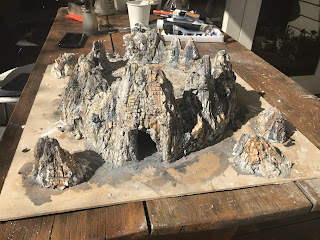My youngest came up to me recently and said, wouldn't it be cool to play a miniatures game based around Cowboys and Aliens (not so much the movie, but the genera in general)! Well, I'd never considered gaming the Old West as an option - no reason, just wasn't my scene. But the idea was intriguing and we were heading toward (what would be months of) isolation and I knew a large terrain project would be just the ticket!
In terms of gaming, there was a plethora of rules to choose from. I wanted a simple set of Old West skirmish rules and have selected
Shootin Iron by Dave Bezio's Grey Area Games. I also thought the Weird West gaming sub-genera might offer a good setting as well and have purchased
Dracula's America: Shadows of the West by Osprey Publishing which looks like it will fill that need admirably.
Construction technique
The main structure of the buildings was made from 5mm foamcore which I got cheap from my local art supplier as it was 'water damaged' (but was fine in reality). In general, I used a wall height of 50mm with the false fronts of the commercial buildings being around 120mm tall. To ensure all the interior spaces were playable, I used removable gable and skillion roof types also made of foamcore.
The exterior wall cladding was made with 190mm x 6mm coffee stirrers using a range of techniques including weatherboard/clapboard, vertical wood sidings and a board and batten siding - a style of exterior siding that uses vertical boards with “batten,” a vertical strip of wood to cover the seams.
Once the cladding was applied with hot glue I textured and weathered it by scratching an exaggerated wood grain into the coffee stirrer and then randomly bevelling the edges and cutting cracks into the ends of planks.
The false fronts common to this era of commercial buildings were cut to a range of shapes to add a bit of interest and a combination of vertical and horizontal cladding applied to create a space for the signage and to add some character.
Flooring was added using the same coffee stirrers and textured the same way as the cladding.
Roofing types used included tar paper and battens, shingles and occasionally some corrugated iron. The shingles were cut from cardboard with each shingle being 5mm x 5mm. For the tar paper I used very fine grit 'wet and dry' sandpaper with wood battens. Corrugated iron was just corrugated craft paper.
The finish I wanted for the buildings was that of very aged timber - timber that had not been painted for a long time (if at all) - giving a run down, or possibly abandoned appearance. I used Platypus Scotsman's Grimdark Church as inspiration. I also took some inspiration from an old church I saw in West Bendigo during a stay in the Victorian Goldfields last winter (in the 2 weeks between months-long lockdowns for COVID!).  |
| This old Protestant Church was converted into a recording studio |
 |
| Poppet head on the Nell Gwynne Reef in West Bendigo. It was a cold, foggy stay (just as I like it) |
The exterior surfaces were painted using the following technique:
- Coat all surfaces with a mix of Matte Mod Podge and black paint (using the method described by Black magic Craft).
- Brush all surfaces with a dark grey using a fairly wet brush to get good coverage (but leaving a little back in the deeper texture.
- Dry brush with a light grey
- Then add a very light dry brush of white.
- Using an Army Painter mid-brown wash I add some semi-random colour variations tot he planks
- Coat the whole surface with a black wash - like Mel describes here:
- Once it is completely dry, add very selective light grey and then white dry brushing to highlights using downward stroked to pick up surfaces light would hit.
- Finally, using a flat scraper in a carving tool set, I gently work all the surfaces to scrape off any thick areas of colour - this gives a very worn, aged look tot he exterior surface.
 |
| Blurry, but atmospheric! Figures by Artizan. |
Doors are wither cut from wider 'tongue depressor' style sticks or were legend and brace doors made up using the coffee stirrers.
Windows were made using thick clear plastic from take away food containers (the rectangular type) and very thin basswood strips obtained from a model railway supplier. I cut the plastic to the size of the window opening (all windows included vertical window frames that the plastic could be glued to) and then glued (with super glue) the basswood to the outer edge and to provide the mullions in the window. Just make sure you paint it to the final colour before you glue it onto the plastic as you can see the timber colour from the insider (found that out the hard way!).
 |
| Eyeing off the 'hoopleheads' from the balcony of the saloon. |
All of my techniques need a lot of refining - especially the doors and windows - but this project certainly kept me entertained in the quiet moments of the first wave of COVID.


















































